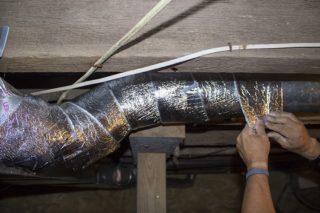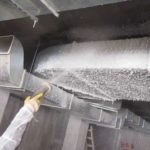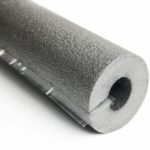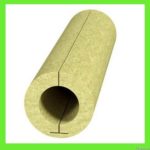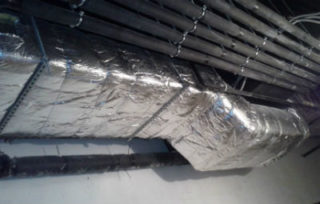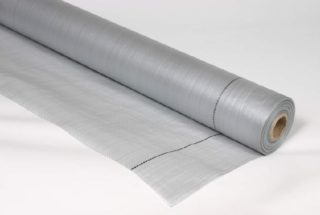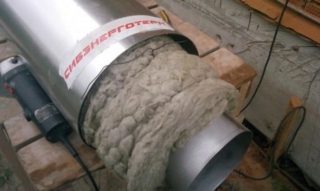Ventilation is one of the main human life support systems. Its proper operation provides clean indoor air. In order for the system to function continuously, it must be insulated. This is the boundary between the contact of cold and warm air and, as a result, the area of occurrence of condensate. Duct insulation is a common protective procedure, without which no construction will take place.
Benefits and Disadvantages
Thermal insulation of ducts has the following advantages:
- prevention of condensation on surfaces (external, internal) and all the negative consequences that it entails;
- heat loss reduction;
- protection against noise arising during ventilation;
- providing fire resistance in order to avoid the spread of fire if a fire occurs.
The disadvantages include:
- considerable costs;
- if improperly performed work is required to insulate the air duct or use poor-quality materials, mold and fungi may occur, which is hazardous to health;
- the insulation used can release substances that are harmful to people.
Thermal insulation of ventilation ducts accelerates the upward movement of air, thereby improving the quality of the entire system.
The main types of insulation
As a heater for ventilation, different types of materials are used that differ in properties and characteristics:
- Mineral wool. The heater effectively performs its task, providing reliable thermal insulation. Mineral wool does not burn at all, which complies with fire safety regulations. In it, mold does not occur and fungi do not start. With all this, the material has an affordable price.
- Basalt fiber. This is a quality type of mineral thermal insulation, which is resistant to high temperature, aggressive environment, ultraviolet. Fiber is a non-combustible material. It is made in the form of plates, mats, shells. The main disadvantage is that it absorbs moisture.
- Glass wool. The fiber has much in common with mineral wool (properties, production technology), but also has other characteristics. Due to the fibrous structure, glass wool material is considered an excellent sound insulator. It has high chemical resistance, non-hygroscopic, does not emit toxic substances, it does not have corrosive agents. Non-combustible material.
- The made foam polyethylene. Issued in the form of 10 mm sheets, shells, bundles. At first, a foil coating may be present. Such polyethylene is considered the cheapest material for insulation. Among the shortcomings: does not tolerate high temperatures, ultraviolet light, burns. Pros: does not absorb moisture, durable, ductile.
- Polyurethane foam. Such insulation for ventilation pipes is resistant to moisture, strong, durable, but does not tolerate the effects of ultraviolet radiation. Operating temperature range - (-60 - 80 ° С). Polyurethane foam is a good heat insulator with an affordable price.
- Polyurethane foam
- Foamed polyethylene
- Basalt wool
- Glass wool
The main characteristic of thermal insulation for ventilation is an indicator of thermal conductivity. It must be one of the lowest.
Duct insulation
Condensation during the operation of ventilation systems is considered a serious problem. Water droplets are formed that can damage walls, floors, and ceilings. Over time, under the influence of condensate, the duct fails.
It is possible to avoid condensation by using an insulation device of the required thickness, which will ensure that the temperature indicator on the external insulation surface is not lower than in the room. A feature of this design: the presence of a vapor barrier layer that protects the insulation from moisture. For this, foil coatings are often used. Mineral wool, basalt fiber, polyethylene and others are used as the main part of the insulating layer.
Joints of the insulating layer must be carefully glued with foil tape. Additional fixation of coil insulation is carried out with wire or steel tape.
Fireproof insulation
Ventilation ducts often connect different types of rooms. Therefore, they must be protected by fireproof insulation material. Such measures are required to prevent damage to the ducts by fire in the event of a fire in the building.
For fire insulation equipment, apply:
- Mineral-cotton piercing mats and plates.
- Basalt fiber cylinders.
Mineral wool plates (square section) during installation are fixed with studs and washers for fixing, with screws. Stitched mats (round, rectangular) are sewn with wire. The use of foil mats increases the functionality of the insulating layer, and also improves the appearance of the duct.
In the case of a significant length of vertical ducts, fire insulation is additionally mounted on the ceiling and other building structures. To do this, use steel wire or plates. Fixation methods are defined by fire and building codes.
Recently, flame retardants have been used to improve fire safety. They are applied to the ducts with a brush, roller, using a spray gun. In case of fire, a fireproof barrier is created under the influence of high temperature.
Sound insulation of ducts
The ventilation system (pipes, exhaust hood) can become a source of unwanted noise, from which you need to protect the room. Sound generators are blades of a working fan, valves, dampers and other rotating elements. Part of the noise, vibration is eliminated due to the properties of the materials of which the duct is made. This function is performed by the sleeves, ventilation ducts.
Most of all the noise spreads through metal ducts. In this regard, if the requirements for noise level are high, a noise isolation device is necessary. The use of duct silencers sometimes helps, but ideally, insulation equipment based on basalt or fiberglass.
Noise reduction is also achieved with specially coated boards made of fiberglass. They are installed inside the duct, and the joints are covered with a metal profile.
Thermal insulation thickness
When calculating the density of insulation, it is necessary to take into account two main indicators of the material used for the manufacture of insulation:
- Coefficient of thermal conductivity.
- Heat transfer coefficient.
The thickness of the insulation is directly proportional to the first indicator and inversely proportional to the second: with a small thermal conductivity of thermal insulation, a thin insulation must be used for decoration.
When calculating the thickness of the thermal insulation layer, it is taken into account:
- humidity and temperature in the room;
- thermal conductivity of insulation;
- the difference in temperature in the room and the pipe;
- duct parameters (size, shape).
Any materials for thermal insulation with time absorb a certain amount of moisture, which increases thermal conductivity.
Installation Rules
The ventilation duct insulation technologies in the building and on the street are almost the same. For the first, there is no need to apply a protective layer, since there is no influence of adverse environmental factors. Insulation of ventilation pipes is also required in a cold attic, roof.
Indoors
Insulation is carried out in the same way as for walls, floor:
- The duct is covered with a membrane. It serves as a waterproofing.
- Lay the insulation.
- The insulated air duct is completely covered with another membrane or foil (vapor barriers).
If the insulated pipe for ventilation is located in a room with high humidity or an aggressive environment, the use of protective layers is mandatory.
Outdoors
If there is an old insulation, it needs to be removed, clean the surface from glue and other materials.
- When using rolled or sheet material, the pipe is wrapped several times. An excellent option is self-adhesive thermal insulation for air ducts.
- A reinforcing frame (synthetic, metal) is placed under the polyurethane insulation. They put it on the duct, and fasten the ends.
- They put insulation on the surface, fasten with clamps, wire.
- The insulated ventilation duct is covered with protective material. Most often, a casing made of tin or aluminum sheets is used.
Insulated pipes for ventilation (plastic) in a private house, as a rule, exit through the roof or wall.
Insulate the air duct reliably so that the device does not damage the wind, precipitation.
Materials for insulation of air ducts have different cost and characteristics. Properly designed insulation should provide overall duct protection to extend the life of the entire monitoring system.
